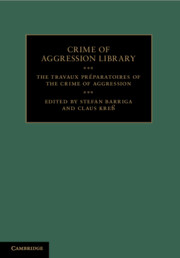Book contents
- Frontmatter
- Contents
- Contributors
- Foreword
- Preface
- Table of documents
- I Introduction to the negotiation history
- II Amendments to the Rome Statute on the Crime of Aggression
- III Historical documents
- IV Travaux Préparatoires of the Amendments to the Rome Statute on the Crime of Aggression (1995–2010)
- V Index of Travaux Préparatoires
Preface
Published online by Cambridge University Press: 05 June 2014
- Frontmatter
- Contents
- Contributors
- Foreword
- Preface
- Table of documents
- I Introduction to the negotiation history
- II Amendments to the Rome Statute on the Crime of Aggression
- III Historical documents
- IV Travaux Préparatoires of the Amendments to the Rome Statute on the Crime of Aggression (1995–2010)
- V Index of Travaux Préparatoires
Summary
During the opening ceremony for signing the treaty on the establishment of an International Criminal Court on 18 July 1998 in Rome, M. Cherif Bassiouni rightly observed that the event ‘marks both the end of a historical process that started after World War I as well as the beginning of a new phase in the history of international criminal justice’. In one fundamentally important respect, however, the Rome regime remained incomplete. It had proven impossible to reach agreement about the definition of that which, on 1 October 1946, was declared the ‘supreme international crime’ by the International Military Tribunal at Nuremberg. Negotiators in Rome disagreed on the definition of the crime and the role of the Security Council in the Court's exercise of jurisdiction, with some delegations objecting to the Court's jurisdiction over this crime altogether. As a compromise, the crime of aggression was added to the subject-matter jurisdiction of the first permanent international criminal court in history, but the Court's exercise of that jurisdiction was postponed. For many observers, this was a postponement ad calendas graecas. States, however, took seriously their mandate to define the crime and formulate conditions for the Court's exercise of jurisdiction over it. The work intensified after 2003 in the framework of the Special Working Group on the Crime of Aggression, established by the Assembly of States Parties to the Rome Statute (ASP). These negotiations proved extremely complex legally and highly sensitive politically.
- Type
- Chapter
- Information
- The Travaux Préparatoires of the Crime of Aggression , pp. xv - xviiiPublisher: Cambridge University PressPrint publication year: 2011

